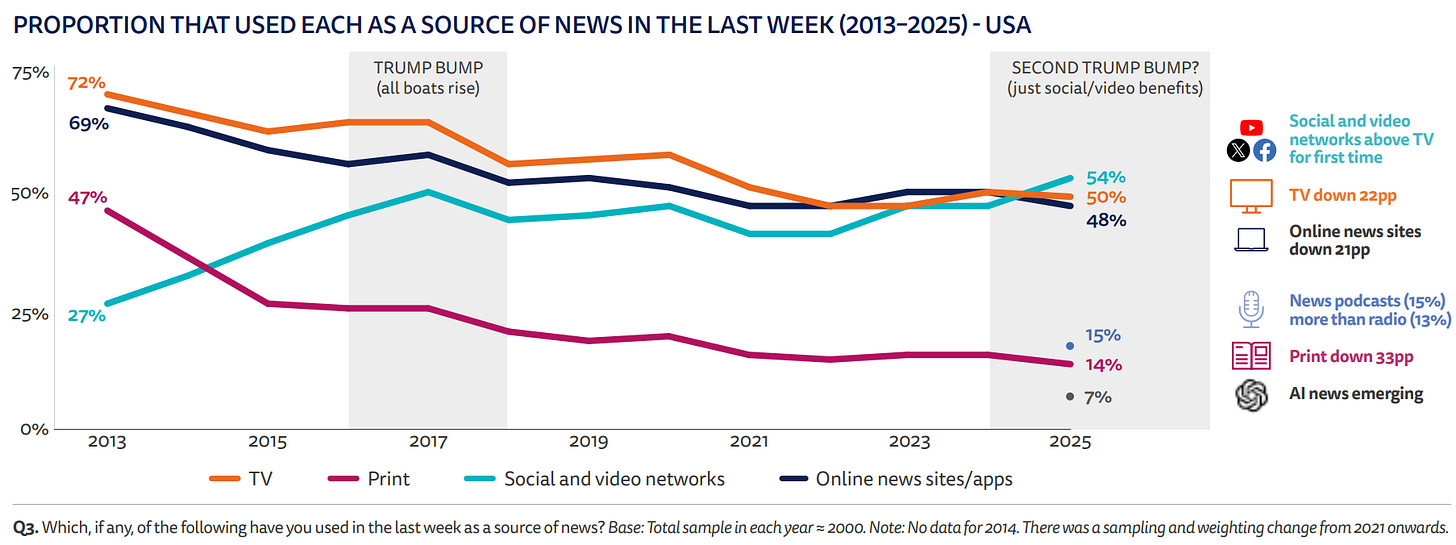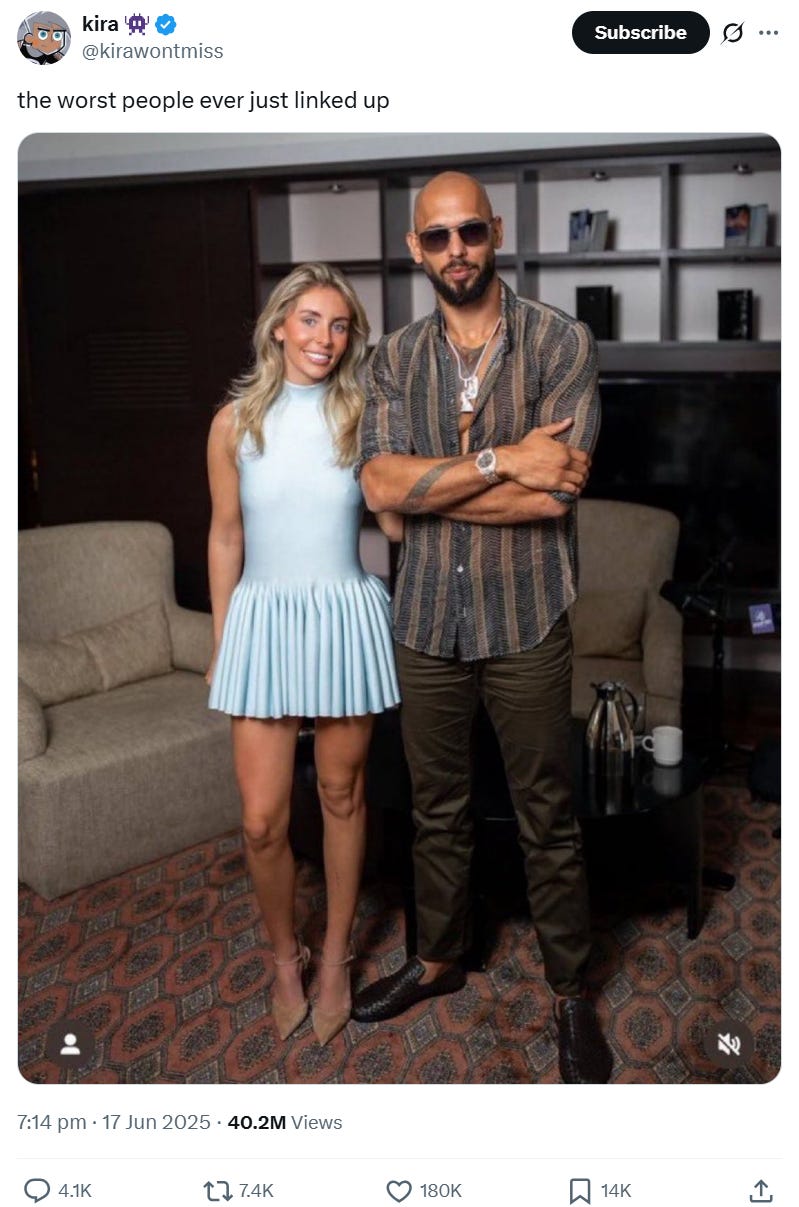Borkowski Media Trends: Kneecap Reinterpret the Rules | Future of Media & MORE
PLUS: Millennial is BACK | Andrew Tate x Bonnie Blue | Evita's PR Coup
Kneecap Reinterpret the Rules of Communications
As Kneecap’s Mo Chara is released on bail after terrorism charges, this year’s Glastonbury Festival is set to continue a long history of political commentary. The case has ignited a passionate fanbase, reinforcing the trio’s message of resistance and why they and their supporters see it as necessary. Their music and messaging may be irreverent, but Kneecap are undeniable masters of a PR strategy, leapfrogging off the success of their self-titled film and utilising every public appearance to deliver uncompromising messaging that they know will generate noise.
Following an impassioned speech against counter terrorism police at Wide Awake Festival, they shouted, “there’s your headlines for tomorrow Daily Mail!” Ahead of Mo Chara’s court date, Kneecap’s Instagram launched a campaign that saw banners appearing across London declaring “more blacks, more dogs, more Irish, Mo Chara.” Everything is shareable, quotable and galvanising on a highly divisive issue with which public discomfort is growing, despite the empathy fatigue and fierce competition for audience attentions of today’s media landscape. Kneecap know that their appearance at Glastonbury (and whether or not the BBC will show it in its entirety) is likely to be the festival’s most talked about moment. And they will come prepared.
What the Reuters State of Digital Media Report means for communications
The dizzying reality of the changing media landscape was laid bare by Reuters Institute’s Digital News Report 2025, published this week.
Unsurprisingly traditional forms of media are losing audience to social platforms at an alarming rate. Here in the UK the smartphone is the gateway to news for almost as many people as television and radio put together. Social media has overtaken television and online news, podcasts have overhauled radio, and LLMs like ChatGPT register significantly as a news source (albeit their output is heavily informed by traditional news sources - even if they don’t always interpret the information they scrape from them correctly).
On these social platforms traditional editorial brands are facing increased competition from ‘creators’. On TikTok 13% more people get their news from influencers - with no editorial accountability, and frequently little-to-no training- than platforms run by journalists.
These influencers, particularly in America, also skew right wing. Joe Rogan, Candace Owens and Tucker Carlson are the most visible, whilst right-wing accounts have been flooding to X at the same rate that the left are abandoning the platform.
But we don’t trust these ‘creators’. They are level with domestic politicians at the top of potential sources of misinformation. Perhaps as a result 40% of us avoid the news completely citing its perceived negativity and information overload as the top reasons.
And technological advances don’t seem to be helping things. The use of AI to both make and consume news is rising sharply, even through we don’t think it will make news any more transparent, trustworthy or accurate. Meanwhile only 18% of us will pay for access to what are generally considered trusted, credible sources of news. All this comes against the backdrop of an explosive MIT study reported in TIME that shows an apparent drop in brain activity amongst those who use ChatGPT to assist them on an essay-writing task.
Here's an analogy; we are gorging on junk food because it is easy-to-consume, attractively branded, and new technology is making it ever-more accessible — even though we can’t trust its ingredients or how it’s been processed, and deep down we know it’s bad for us. Meanwhile a healthy diet is more effort, more than we want to pay, and we don’t really trust the nutrition guidance anyway. So when the junk makes us sick, a lot of us just starve ourselves.
The communications challenge is clear; placing quality news on credible platforms that will reach and influence a significant audience is harder and more sensitive than ever. Even just reaching a mass audience in such a fragmented ecosystem is complex.
We don’t plug ourselves much on this platform so we’ll leave it at this; if you’re going to try to get something in the news, make sure you know what you’re doing, or that you’re working with someone who does...
OMG! The Return of the Millennial
The other day a Gen Z colleague flung 3 CDs onto his desk in a real-life demonstration that, as reported by the New York Times, everything Millennial is cool again. While Y2K aesthetic has dominated fashion circles for the past few years, this revival has now migrated into broader lifestyle trends. What younger generations (born after 1996) once dismissed as outdated and cringe is suddenly desirable again. So, what does this mean for brands?
The New York Times piece on Millennial nostalgia explored how consumers revisit old trends, driven by a longing for familiarity - even if that familiarity has only been bred through popular culture. When brands successfully tap into this paranostalgia, they don’t just sell products, they build a bridge between generations that can launch countless lifestyle trends.
Take the resurgence of wired headphones. Once discarded for their Bluetooth successors, they’ve returned as a style statement (frequently worn by the Hadid sisters, Dua Lipa and Paul Mescal). The instantly recognisable Apple white headphones, in particular, carry an iconic status that transcends function. It’s a perfect example of how consumers gravitate toward familiar, trusted products that evoke simpler times (like the famous iPhone/iTunes commercials of the early 2000s).
This yearning for simplicity is likely a reflection of the complexities of today’s social and news environment. A world saturated by information, social media, and endless connectivity. The return of CDs, VHS tapes, and other analogue relics signals a desire to reclaim control over how we consume media and memories.
For brands, the lesson is clear: nostalgia sells, but only when it’s authentic. Consumers are drawn to products and experiences that connect them with their past, offering a moment of clarity in an otherwise noisy world.
Don’t be surprised if Blackberries and MSN Messenger makes a comeback. BRB.
Andrew Tate x Bonnie Blue: Have we hit peak Ragebait?
If attention is currency, Bonnie Blue and Andrew Tate just tried to print money. This week Blue, fresh from her OnlyFans ban, has elicited controversy once again by appearing in a teaser for Tate’s ‘The Disruptor’ podcast. Tate, till embroiled in legal battles in both Romania and the UK, facing a slew of rape and assault charges, calls Blue “the end result of feminism”, to which she replies “bringing women forward 1057 years” referencing to her recent orgy stunt.
This collab has done nought to rehabilitate the image of either figure, and this symbiosis of what many see as male and female toxicity has been scathingly received. Although unclear when it will air, the teaser has generated a slew of reactions from confusion to outright criticism.
Backlash however, is the point. Both creators thrive on outrage metrics, rage-bait and the attention economy. For Tate this is a deflection tactic, keeping eyeballs on his podcast and not his legal trials, for Blue it provides her with continued attention.
Ragebait has undeniably fuelled the fire of both parties’ fame, but with no deeper narrative and no clear story, it will surely burn out. However much it says about the current state of ‘celebrity’ in the age of the culture wars, this collaboration is a headline and not a legacy — one that reveals how desperate both are for clicks.
Don’t Cry for Me, Auditoria: Evita Has Left the Building
At precisely 9pm each night outside the London Palladium, home to Jamie Lloyd’s new production of Evita, a crowd of up to 600 gathers, phones raised, waiting for Rachel Zegler to appear on a balcony and belt out Don’t Cry for Me Argentina.
It’s a performance the crowd outside didn’t pay for, while those inside shelled out as much as £250 a seat. To some, it’s a visionary coup and a radical act of accessibility; to others, a bold snub to the paying audience. Either way, the discourse is deafening.
The backlash has included accusations of a PR stunt, noise complaints, and grumbles that the audience inside misses the show’s most iconic number. Some critics argue the traditional theatre experience is being diminished by the outdoor spectacle.

 Tiktok failed to load.
Tiktok failed to load.Enable 3rd party cookies or use another browser
But the headlines miss the mark. This is not simply a (very good) stunt. It’s a deliberate artistic choice by Jamie Lloyd - the kind of symbolic, multimedia fusion of film and live theatre that defines his work. Crucially, it’s faithful to the story: Evita has always been about public performance and political theatre. Eva Perón’s iconic speeches weren’t whispered to elites, they were broadcast to the masses below.
It’s also a savvy PR turn for Zegler, who’s weathered backlash from Snow White to social media storms. Strategically cast as the adored yet divisive Eva, she seems self-aware of the parallels. Choosing to face the crowd head-on, reclaiming her narrative and winning back public affection
Ultimately, the balcony performance is a perfect encapsulation of Evita's message, bringing the story vividly to life for the genuine public. Thousands who might never afford a West End ticket have witnessed a star turn live and up close. And those who can afford do seem to be buying tickets - even on a weekend where the weather forecast is not the most theatre-friendly tomorrow’s matinee looks nearly sold out.








